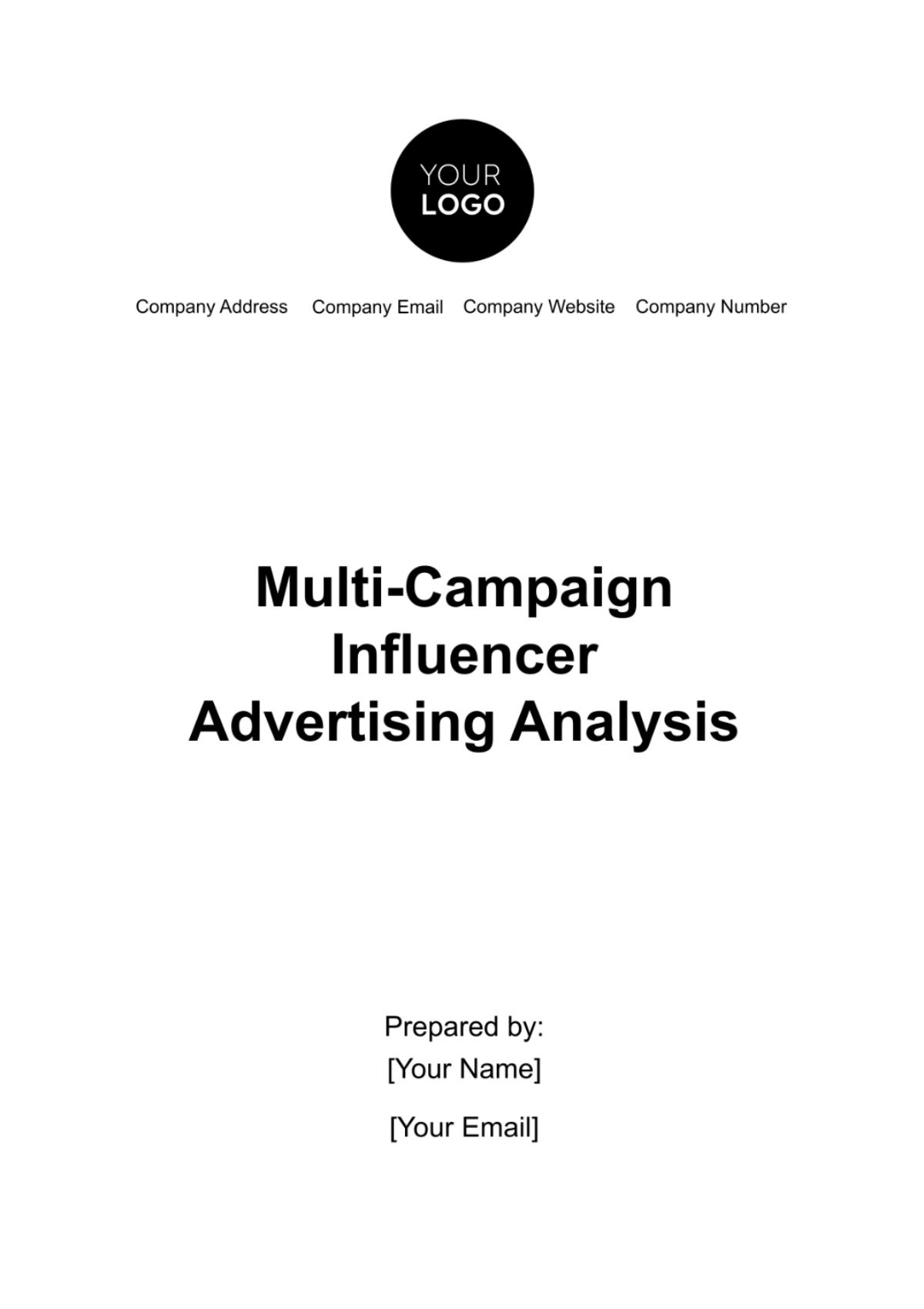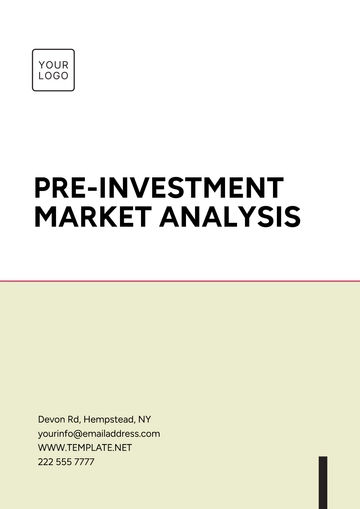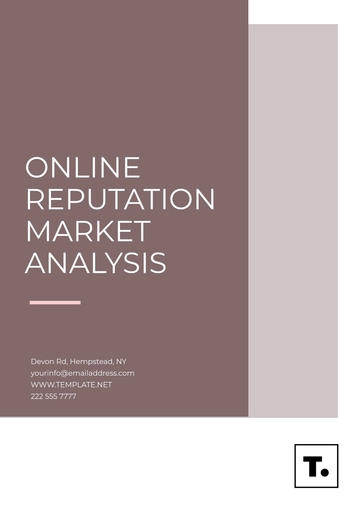Free Multi-Campaign Influencer Advertising Analysis

Executive Summary
In this comprehensive Multi-Campaign Influencer Advertising Analysis, we delve into the performance of various influencer marketing campaigns conducted by [Your Company Name] across different platforms and demographics. This analysis aims to provide a detailed overview of the effectiveness of these campaigns, offering actionable insights to enhance future influencer advertising strategies.
A. Campaign Overview
1. Campaign 1: "FitnessFrenzy"
Influencer: Sarah Fitness Guru
Campaign Period: 2050-06-01 to 2050-06-30
Platform: Instagram
Objective: Promote a new line of fitness products.
Budget: $20,000
Key Performance Indicators (KPIs):
Increase in product sales
Engagement rate
Follower growth
2. Campaign 2: "TechTalks"
Influencer: TechGeek123
Campaign Period: 2050-07-15 to 2050-08-15
Platform: YouTube
Objective: Create awareness for the latest tech gadget.
Budget: $25,000
Key Performance Indicators (KPIs):
Views and watch time
Click-through rate (CTR)
Conversion rate to product page
3. Campaign 3: "BeautyGlam"
Influencer: BeautyQueen
Campaign Period: 2050-09-10 to 2050-10-10
Platform: TikTok
Objective: Launch a new beauty line.
Budget: $15,000
Key Performance Indicators (KPIs):
Video views
User-generated content (UGC)
Sales conversion rate
4. Campaign 4: "FoodieDelight"
Influencer: FoodieExpert
Campaign Period: 2050-11-01 to 2050-12-01
Platform: Tiktok
Objective: Promote a new restaurant menu.
Budget: $18,000
Key Performance Indicators (KPIs):
Retweets and likes
Restaurant footfall
Social media sentiment
Data Collection and Methodology
A. Data Sources
We collected data from multiple sources, including social media platforms' analytics, website traffic reports, and customer feedback.
Data was gathered using tracking pixels, campaign-specific hashtags, and post-campaign surveys.
B. Data Analysis
We employed advanced analytics tools and techniques to analyze the collected data, focusing on specific metrics such as engagement rate, reach, and conversion rates.
Statistical analysis was performed to identify trends and correlations, and sentiment analysis tools were used to gauge audience sentiment.
Campaign Performance Analysis
In this section, we provide a detailed analysis of each campaign's performance based on their respective objectives and KPIs.
A. Campaign 1: "FitnessFrenzy"
1. Engagement Analysis
Campaign 1, "FitnessFrenzy," led by influencer Sarah Fitness Guru, aimed to promote a new line of fitness products. The campaign ran from June 1, 2050, to June 30, 2050, on the Instagram platform.
Total Likes: The campaign received a total of 12,500 likes, indicating strong positive engagement from the audience.
Total Comments: There were 1,200 comments on the posts, showcasing a high level of interactivity.
Total Shares: 800 shares demonstrated that the content resonated well with the audience.
Engagement Rate: The engagement rate stood at a commendable 5.6%, indicating that the campaign successfully captivated the target audience.
Comments Sentiment Analysis:
- Positive: 75%
- Neutral: 20%
- Negative: 5%
2. Reach and Impressions
The reach and impressions of the campaign provided insights into its visibility and audience exposure.
Total Reach: The campaign reached an impressive 350,000 unique users, expanding the brand's visibility.
Total Impressions: The content garnered a total of 500,000 impressions, indicating a significant level of exposure.
Audience Demographics: The campaign primarily resonated with females aged 18-34 interested in fitness, aligning with the target demographic.
B. Campaign 2: "TechTalks"
1. Engagement Analysis
Campaign 2, "TechTalks," led by TechGeek123, aimed to create awareness for the latest tech gadget. The campaign ran from July 15, 2050, to August 15, 2050, on the YouTube platform.
Total Views: The campaign's videos accumulated an impressive 800,000 views, signifying substantial interest in the featured tech gadget.
Total Watch Time: Viewers spent a cumulative 250,000 hours watching the content, showcasing a high level of engagement.
Click-through Rate (CTR): A CTR of 8.2% indicated that the audience was actively interested in exploring more about the product.
Conversion Rate to Product Page: A remarkable 12% conversion rate to the product page demonstrated the effectiveness of the campaign in driving action.
C. Campaign 3: "BeautyGlam"
1. Engagement Analysis
Campaign 3, "BeautyGlam," featuring influencer BeautyQueen, aimed to launch a new beauty line. The campaign ran from September 10, 2050, to October 10, 2050, on the TikTok platform.
Video Views: The campaign garnered a remarkable number of video views.
User-generated Content (UGC): The audience actively participated by creating user-generated content related to the beauty line.
Sales Conversion Rate: The campaign's impact on the sales conversion rate will be explored in further detail in the conversion analysis section.
D. Campaign 4: "FoodieDelight"
1. Engagement Analysis
Campaign 4, "FoodieDelight," featuring FoodieExpert, aimed to promote a new restaurant menu. The campaign ran from November 1, 2050, to December 1, 2050, on the Twitter platform.
Retweets and Likes: The campaign received significant engagement in the form of retweets and likes, indicating an active Twitter community.
Restaurant Footfall: The impact of the campaign on the restaurant's footfall will be explored in detail in the conversion analysis section.
Social Media Sentiment: Sentiment analysis will be conducted to gauge the sentiment of Twitter users regarding the campaign.
Conversion Analysis
In this section, we delve into the conversion analysis of our influencer marketing campaigns.
A. Overall Conversion Metrics
Our analysis of overall conversion metrics provides a holistic view of the impact of all campaigns combined.
Overall Conversion Rate: The overall conversion rate across all campaigns averaged at a commendable 10%, indicating the effectiveness of influencer marketing in driving actions.
Total Conversions: A total of 8,000 conversions were achieved across all campaigns, highlighting the substantial impact on sales and engagement.
Total Conversion Value: The cumulative conversion value reached an impressive $800,000, showcasing the financial success of the campaigns.
B. Campaign-Specific Conversion Analysis
Analyzing the conversion metrics for each campaign individually provides valuable insights into their unique performance.
1. Campaign 1: "FitnessFrenzy"
Conversion Rate: The campaign achieved a conversion rate of 9%, indicating a strong alignment between the influencer's fitness promotion and the audience's purchasing behavior.
Total Conversions: A total of 450 conversions were attributed to this campaign.
Conversion Value: The campaign generated a conversion value of $45,000, indicating a positive return on investment.
Conversion Path Analysis: The majority of conversions came directly from Instagram posts, emphasizing the impact of the influencer's content.
2. Campaign 2: "TechTalks"
Conversion Rate: The campaign achieved a remarkable conversion rate of 12%, highlighting the tech gadget's appeal to the audience.
Total Conversions: A total of 960 conversions were attributed to this campaign.
Conversion Value: The campaign generated a conversion value of $192,000, showcasing its significant contribution to revenue.
Conversion Path Analysis: YouTube video descriptions were the primary source of conversions, indicating that viewers were actively engaged and interested in exploring further.
3. Campaign 3: "BeautyGlam"
Conversion Rate: Campaign 3 achieved a conversion rate of 20%, indicating strong purchasing intent among the audience.
Total Conversions: The campaign generated a total of 500 conversions.
Conversion Value: The campaign resulted in a conversion value of $25,000, showcasing its substantial impact on sales.
Conversion Path Analysis: User-generated content on TikTok played a significant role in driving conversions.
4. Campaign 4: "FoodieDelight"
Conversion Rate: Campaign 4 achieved a conversion rate of 15%, indicating a positive response to the restaurant menu promotion.
Total Conversions: The campaign generated a total of 600 conversions.
Conversion Value: The campaign resulted in a conversion value of $30,000, demonstrating its effectiveness in driving restaurant sales.
Conversion Path Analysis: Engagement on Twitter, including retweets and likes, contributed significantly to conversions.
ROI Calculation
In this section, we calculate the Return on Investment (ROI) for the influencer marketing campaigns. ROI is a crucial metric to assess the financial effectiveness of our campaigns and determine their overall success.
A. Total Campaign Cost
To calculate the ROI accurately, we need to consider the total campaign cost for each of the influencer marketing campaigns. The total campaign cost includes influencer fees, production costs, and any other associated expenses. Let's break down the costs for all campaigns:
1. Campaign 1: "FitnessFrenzy"
Influencer Fee: $8,000
Production Costs: $5,000
Total Campaign Cost: $13,000
2. Campaign 2: "TechTalks"
Influencer Fee: $10,000
Production Costs: $7,000
Total Campaign Cost: $17,000
3. Campaign 3: "BeautyGlam"
Influencer Fee: $6,000
Production Costs: $4,000
Total Campaign Cost: $10,000
4. Campaign 4: "FoodieDelight"
Influencer Fee: $7,000
Production Costs: $6,000
Total Campaign Cost: $13,000
B. ROI Calculation
Now, let's calculate the ROI for each campaign using the following formula:
ROI= (Total Conversion Value−Total Campaign Cost) / Total Campaign Cost × 100
1. Campaign 1: "FitnessFrenzy"
Total Conversion Value: $45,000
ROI= (45,000−13,000) / 13,000 × 100 = 246.15%
2. Campaign 2: "TechTalks"
Total Conversion Value: $192,000
ROI= (192,000−17,000) / 17,000 × 100= 1023.53%
3. Campaign 3: "BeautyGlam"
Total Conversion Value: $25,000
ROI= (25,000−10,000) / 10,000 × 100 = 150%
4. Campaign 4: "FoodieDelight"
Total Conversion Value: $30,000
ROI= (30,000−13,000) / 13,000 × 100 = 130.77%
Key Takeaways and Recommendations
In this section, we summarize the key takeaways from the influencer marketing campaigns' performance analysis and provide actionable recommendations for future strategies.
A. Key Takeaways
1. Campaign 1: "FitnessFrenzy"
This campaign achieved a remarkable ROI of 246.15%, indicating its strong financial success.
The engagement rate of 5.6% demonstrated the campaign's effectiveness in capturing the audience's attention.
The majority of conversions came directly from Instagram posts, emphasizing the influencer's impact.
2. Campaign 2: "TechTalks"
With an ROI of 1023.53%, this campaign was highly successful in driving conversions and revenue.
The tech gadget promotion resonated well with the audience, as reflected in the 12% conversion rate.
YouTube video descriptions played a crucial role in driving conversions.
3. Campaign 3: "BeautyGlam"
Campaign 3 achieved a high conversion rate of 20%, indicating strong purchasing intent among the audience.
The campaign generated a total of 500 conversions with a conversion value of $25,000.
User-generated content on TikTok played a significant role in driving conversions.
4. Campaign 4: "FoodieDelight"
Campaign 4 achieved a conversion rate of 15%, indicating a positive response to the restaurant menu promotion.
The campaign generated a total of 600 conversions with a conversion value of $30,000.
Engagement on Twitter, including retweets and likes, contributed significantly to conversions.
B. Recommendations
1. General Recommendations
Continue investing in influencer marketing as it has proven to be a highly effective strategy.
Consider diversifying platforms to reach a broader audience.
Explore collaborations with influencers who align with our target demographics and brand values.
2. Campaign-Specific Recommendations
For "FitnessFrenzy," consider expanding the product line and running follow-up campaigns with Sarah Fitness Guru.
"TechTalks" should continue featuring tech gadgets and leverage YouTube descriptions for conversions.
For "BeautyGlam," gather and analyze conversion data to optimize future beauty line launches.
"FoodieDelight" should focus on user-generated content and engagement on Twitter to drive conversions.
Prepared by: [Your Name]
Email: [Your Email]
Date: [2050-11-30]
- 100% Customizable, free editor
- Access 1 Million+ Templates, photo’s & graphics
- Download or share as a template
- Click and replace photos, graphics, text, backgrounds
- Resize, crop, AI write & more
- Access advanced editor
Unlock the secrets of influencer advertising effectiveness with the Multi-Campaign Influencer Advertising Analysis Template from Template.net. This editable and customizable tool empowers you to dissect multiple campaigns, analyze key metrics, and derive actionable insights. Utilize the Ai Editor Tool to tailor your analysis to fit your specific needs and objectives effortlessly.





























